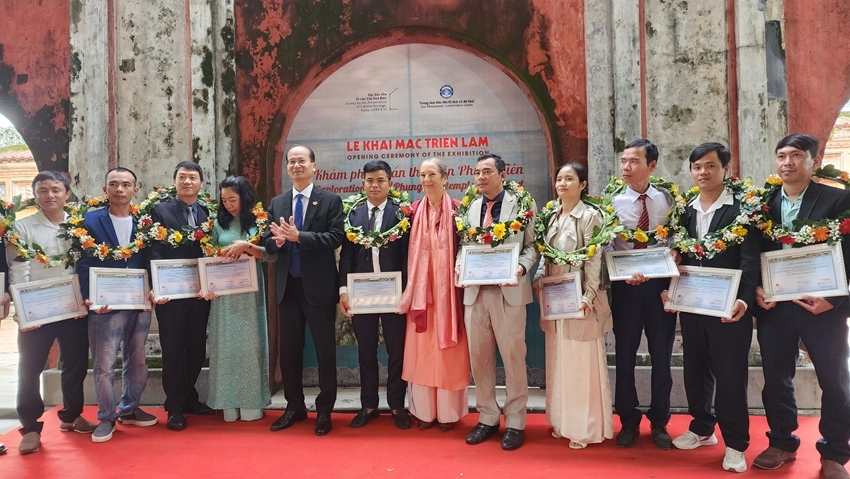 |
| Awarding certificates and certificates of merit to students and members of the project at the opening ceremony of the exhibition |
The exhibition is within the framework of the Heritage Conservation Cooperation Project between Hue Monuments Conservation Center and the GEKE (in the period of 2017 - 2026) on preserving, restoring, and virtually reconstructing the existing architecture, integrating technical training for students at the Phung Tien temple, Hue Imperial City in the period of 2021 - 2026.
As one of the five important temples/shrines of the Nguyen Dynasty, the Phung Tien temple was originally named Hoang Nhan temple, which was built in the 13th year of Gia Long reign (in 1814) in the north of Trieu temple, to worship Queen Thua Thien Cao, the main wife of Emperor Gia Long. Later, the temple became a place to worship emperors and queens of the Nguyen Dynasty. In 1829, Emperor Minh Mang renamed the temple to Phung Tien temple; and in 1837, Phung Tien temple was moved to its present location. At that time, the structure of Phung Tien temple was built according to "the method of the The temple, changed into 9 compartments, the temple was in the front, and the shrine was in the back".
 |
| Exploring the virtual reconstruction of the Phung Tien temple |
The Phung Tien temple’s precinct consists of 5 main buildings, including the main hall, the East - West Coordination hall, the Left - Right Tong Vien, and many other affiliated buildings such as the gate systems, doors, guarding screens, and rockery pools, etc.
In 1947, this site was destroyed, leaving only the gates, the surrounding wall system and the back guarding screen. From 2017 up to now, Phung Tien temple compound has been restored through a cooperation project between Vietnam and the Federal Republic of Germany to preserve the remaining structures and revive the original shape and function of the compound.
In the period of 2020 - 2023, the project preserved and restored the back guarding screen, gates and walls surrounding the site, recreated the image of this monument through the virtual reconstruction of the overall architecture of the Phung Tien temple. In the same period, the project also provided technical training for 11 students of the project, who are artists and skilled craftsmen in the province; as well as organizing the exploration of Phung Tien temple relic for 13 classes of nearly 200 students, with several programs such as "Coloring heritages, Preserving heritages; Hue Arts memory game; 3D creativity; and the Frescoc - Traditional painting technique for murals, building decoration and restoration"; especially, virtual reconstruction in the form of visual overlay of the existing space with a graphic model of the Phung Tien temple compound.
According to the Director of Hue Monument Conservation Center, Mr. Hoang Viet Trung, this exhibition gives visitors the opportunity to learn about the architecture, the spiritual life of the Nguyen Dynasty, as well as the cultural, historical and fine arts values in this period via the virtual reconstruction of the Phung Tien temple.
With the above mentioned meanings and achievements, the project once again affirms the deep interest of the local authority and the Ministry of Foreign Affairs of the Federal Republic of Germany, as well as specialized research organizations from Germany in the conservation and promotion of the values of Hue ancient capital’s relics.
